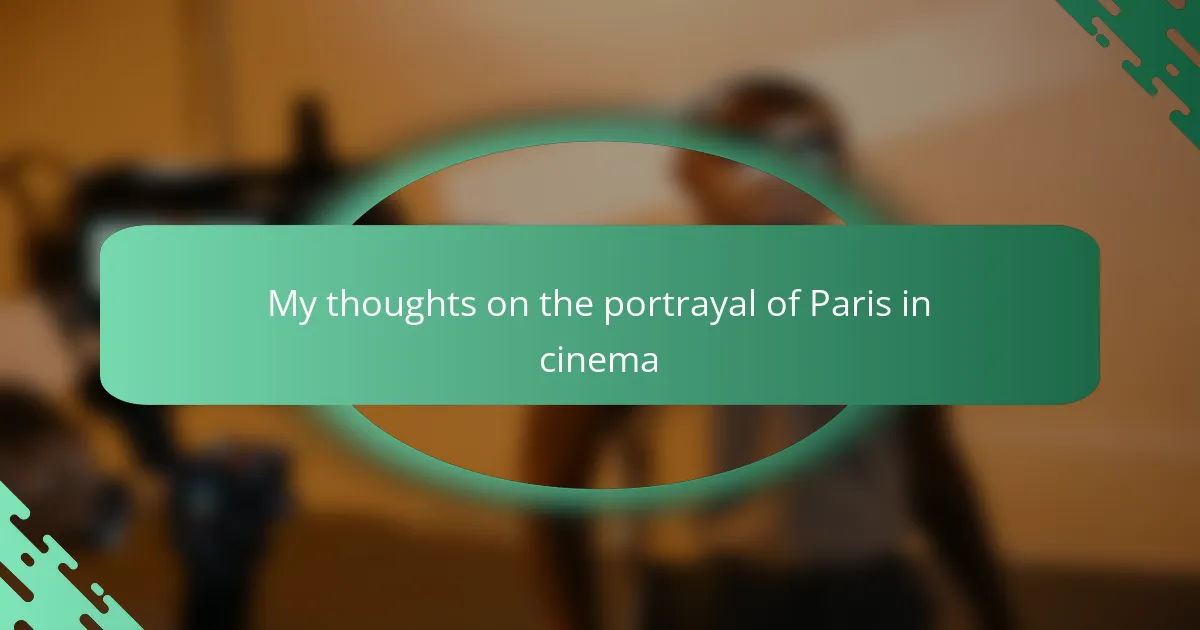Key takeaways
- Paris is a vital character in films, influencing narratives through its iconic landmarks and cultural vibe.
- Setting plays a crucial role in enhancing emotional connections, as seen in films like “Amélie” and “Midnight in Paris.”
- Movies set in Paris not only romanticize the city but also reveal its complexities and challenges, encouraging deeper storytelling.
- Parisian films inspire wanderlust and a desire to explore the city beyond its surface, connecting personal experiences with cinematic portrayals.
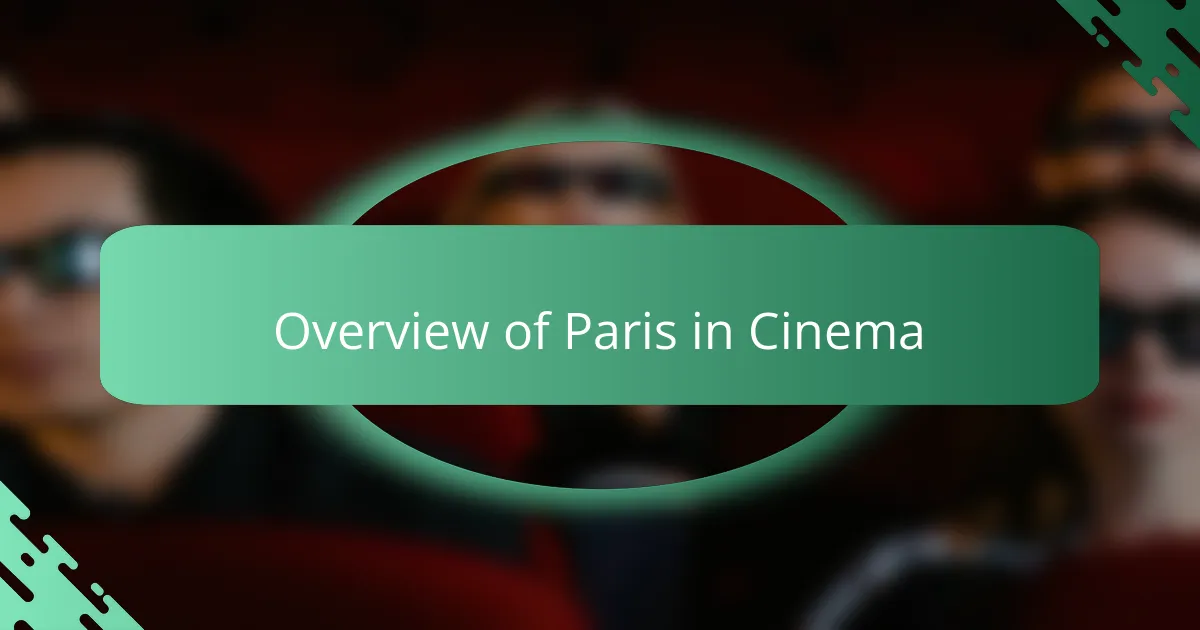
Overview of Paris in Cinema
Paris has long been a muse for filmmakers, embodying romance, artistry, and a unique cultural spirit. I’ve often found myself captivated by how the city’s iconic landmarks—like the Eiffel Tower and the Seine—are used to enhance narratives. It’s fascinating to see how each director interprets these visuals, often infusing them with personal emotions and experiences that resonate deeply with audiences.
In cinema, Paris isn’t just a backdrop; it serves as a character in its own right. Many films capture the essence of life in the city, from bustling cafes to quiet gardens. The portrayal can vary dramatically, reflecting both the light and shadow of Parisian life.
- Iconic Landmarks: Locations like Montmartre and Notre-Dame symbolize artistic inspiration and history.
- Cultural Vibes: The city’s rich culture influences character development and plot lines.
- Emotional Undertones: Many films evoke nostalgia or longing, often mirroring personal connections I feel toward my own experiences in the city.
- Diverse Narratives: From romance to drama, Paris has played a crucial role in shaping diverse cinematic stories.
- Unique Aesthetics: The use of light and color in films set in Paris often adds to the storytelling, leaving a lasting impression.
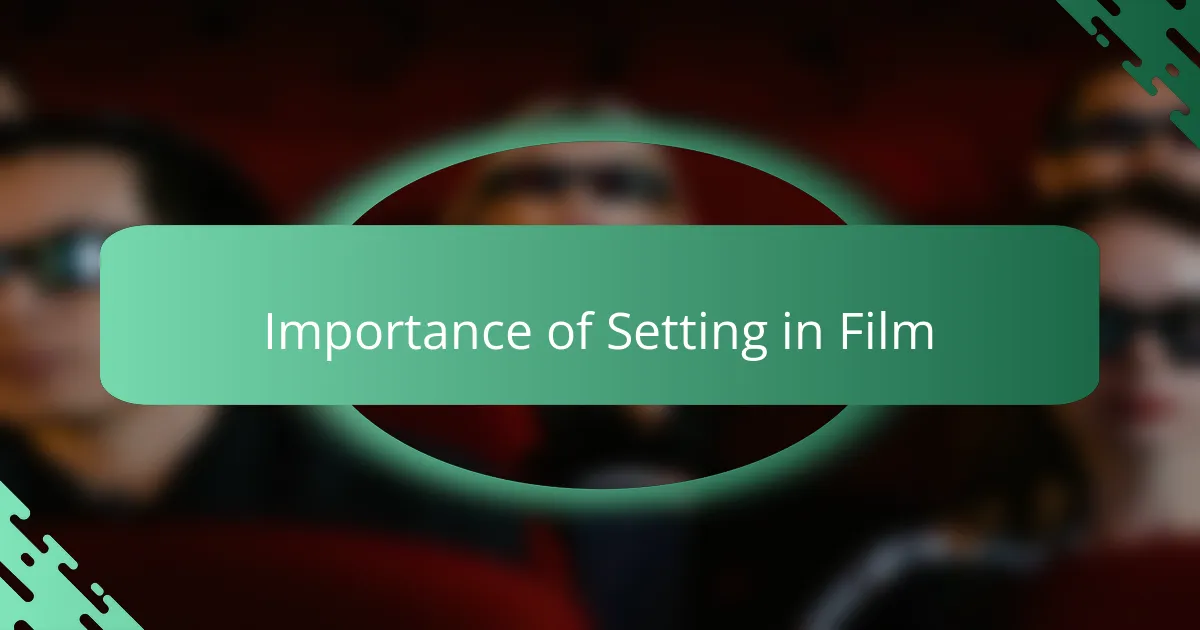
Importance of Setting in Film
Setting plays a crucial role in film, especially when it comes to a city as vibrant as Paris. The city’s streets, landmarks, and atmosphere create a backdrop that enhances the narrative and evokes emotions in the audience. I remember watching “Amélie” for the first time; the way Paris was portrayed made me feel as if I were wandering through its magical streets myself, connecting deeply with the characters.
In contrast, films like “Midnight in Paris” use the setting to not only tell a story but also to create a dialogue between different time periods. This can evoke nostalgia and a sense of longing. The streets of Paris become a character on their own, shaping the journey of the protagonists and influencing their choices in profound ways.
Here’s a comparison of the significance of Paris as a setting in a few notable films:
| Film | Significance of Setting |
|---|---|
| Amélie | Creates a whimsical and romantic atmosphere, showcasing the charm of everyday life in Paris. |
| Midnight in Paris | Blends past and present, exploring nostalgia and the longing for a different time in the enchanting Parisian landscape. |
| Les Misérables | Uses gritty urban settings to reveal social issues and the struggles of its characters, showcasing a different, raw perspective of Paris. |

Key Movies Featuring Paris
The cinematic landscape of Paris is dotted with films that have become cornerstones of the romantic genre. Think about “Moulin Rouge!”—this film captures not just love but the city’s vibrant nightlife. It’s hard not to feel a rush of excitement when witnessing the electrifying dance numbers set against the twinkling lights of the Eiffel Tower. It resonates with me personally because it brings back memories of my own visits to the iconic cabarets, where the air is thick with the scent of creativity and passion.
Another gem that springs to mind is “Before Sunset.” The film’s realism and raw dialogue are beautifully set against the backdrop of Paris, making the city feel like an integral part of the characters’ journey. I find myself pondering, can a place truly impact how we connect with others? The film suggests that in Paris, the moments shared are amplified by the history and beauty that envelops you, creating a kind of magic that is hard to replicate elsewhere.
Then there’s “Paris, Je T’aime,” a unique anthology where each short film captures different stories throughout the city. It’s wonderful how the film explores love in various forms—romantic, familial, and even platonic. Each narrative, while distinct, feels like a small piece of a larger puzzle that reflects the diverse heartbeat of the city. This film reminds me how personal experiences can shape our understanding of love and connection, making the portrayal of Paris not just beautiful, but profoundly relatable.
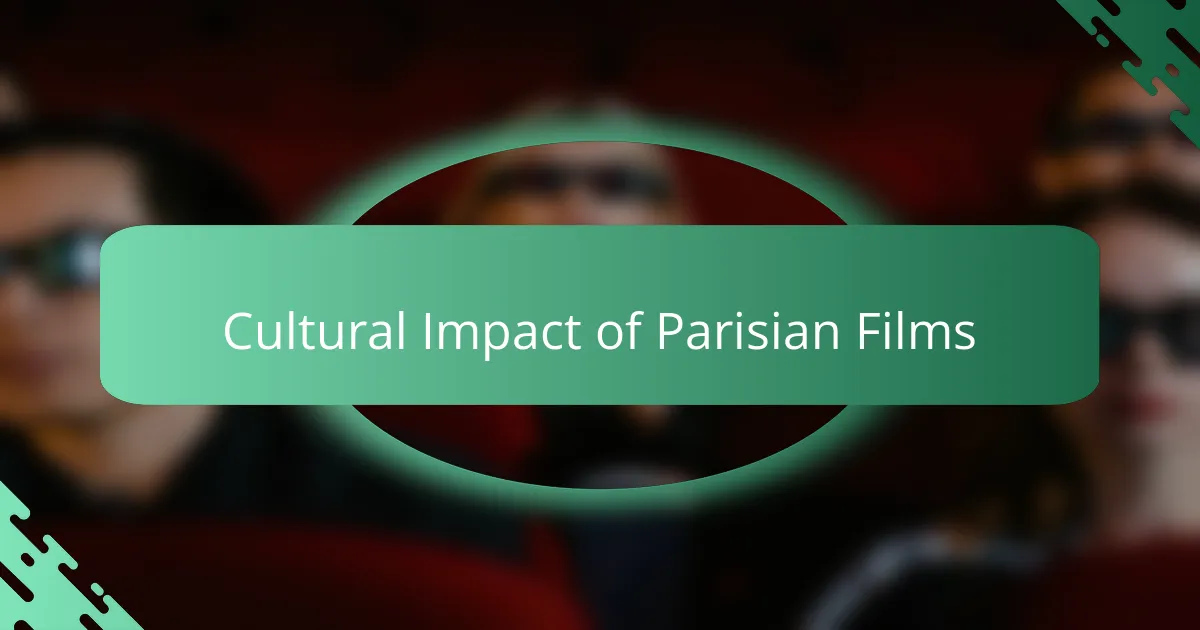
Cultural Impact of Parisian Films
Cultural impact in cinema is often shaped by the cities where stories unfold, and Paris is a prime example. I’ve noticed that films set in Paris not only showcase the city’s iconic landmarks but also deeply resonate with the themes of love, art, and existential exploration. For me, watching a romance blossoming under the enchanting glow of the Eiffel Tower feels like a beautiful affirmation of the city’s charm.
Furthermore, Parisian films have a unique ability to influence fashion and lifestyle trends worldwide. I’ve found that after watching movies like “Midnight in Paris,” I often feel inspired to adopt a more effortless Parisian style in my own wardrobe. It’s fascinating how a simple scene in a Café de Flore can spark a desire to savor life’s moments more intently.
| Film | Cultural Impact |
|---|---|
| Amélie | Highlights the whimsical side of Paris, sparking interest in Montmartre and café culture. |
| Midnight in Paris | Revives interest in 1920s literary figures and romantic nostalgia for the city. |
| Paris, Je T’aime | An anthology that showcases diverse stories, capturing the city’s multifaceted identity. |
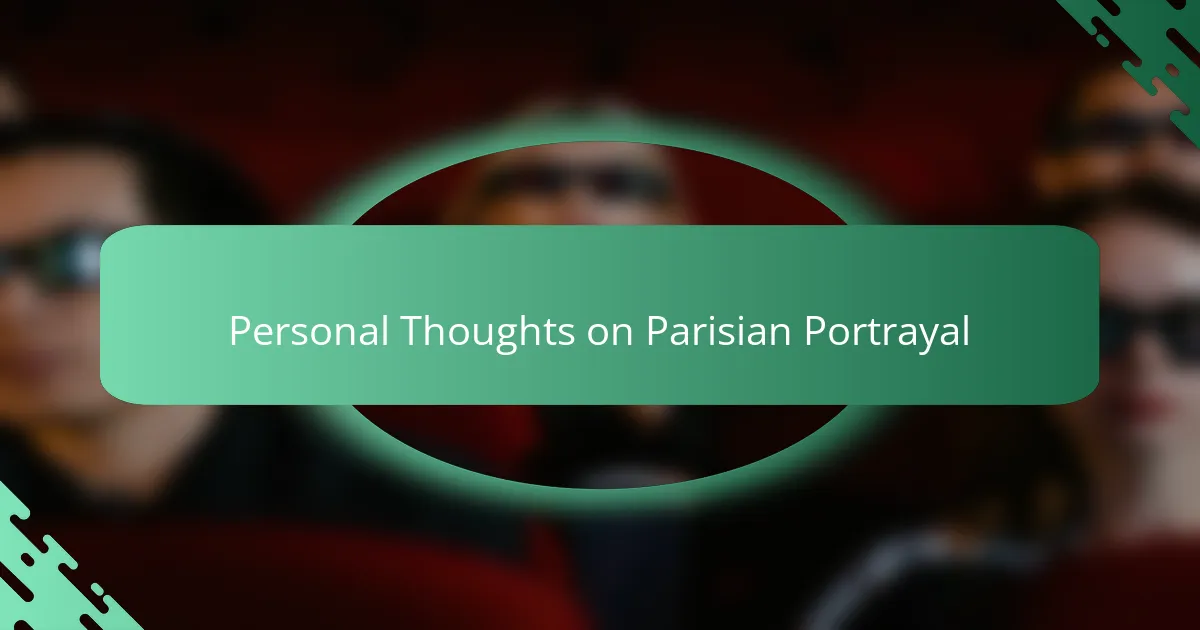
Personal Thoughts on Parisian Portrayal
When I think about the portrayal of Paris in cinema, I can’t help but feel a mix of nostalgia and admiration. Films often capture the city’s romantic charm, from the twinkling lights of the Eiffel Tower to the cozy cafes lining the cobblestone streets. I remember watching “Midnight in Paris” for the first time and being transported through time and space, feeling as if I could almost smell the croissants fresh out of the bakery.
However, there’s a more nuanced side to Paris that films sometimes overlook. It’s not always the glamorous backdrop; it can also be a city of challenges, reflecting the complexities of life. That’s what makes the portrayal authentic and relatable. Here are some key points I reflect on regarding Paris in films:
- The romanticization of Paris often ignores its vibrant, diverse culture.
- Many films fail to present the everyday life of Parisians, focusing instead on cliches.
- Cinematic views of Paris can spark a wanderlust that encourages exploration beyond the surface.
- The city’s history is rich and layered, providing fertile ground for deeper storytelling.
- Personal experiences, like stumbling upon hidden gems, rarely find their way into mainstream narratives.

Favorite Parisian Film Moments
When I think of my favorite Parisian film moments, a few scenes instantly come to mind. One that stands out is from “Midnight in Paris,” where Gil meanders through the rain-soaked streets, filled with a sense of nostalgia and wonder. The way the city is captured in its Arthurian splendor makes me yearn for a time that feels both familiar and distant.
Another memorable moment is from “Amélie,” where our whimsical protagonist interacts with the quirky Parisian life around her. The vibrant colors and charming details made me appreciate the small joys in everyday life. It’s these moments that resonate deeply, making Paris not just a backdrop, but a character in its own right.
I often reminisce about a trip to Paris that echoed these films. Walking those same rain-kissed streets, I felt as if I had stepped right into the scenes I adored. It’s remarkable how cinema can intertwine with our own experiences, breathing life into places we cherish.
| Film | Memorable Scene |
|---|---|
| Midnight in Paris | Gil walking through rain-soaked streets, experiencing nostalgia |
| Amélie | Amélie’s adventures in quirky, colorful Paris life |
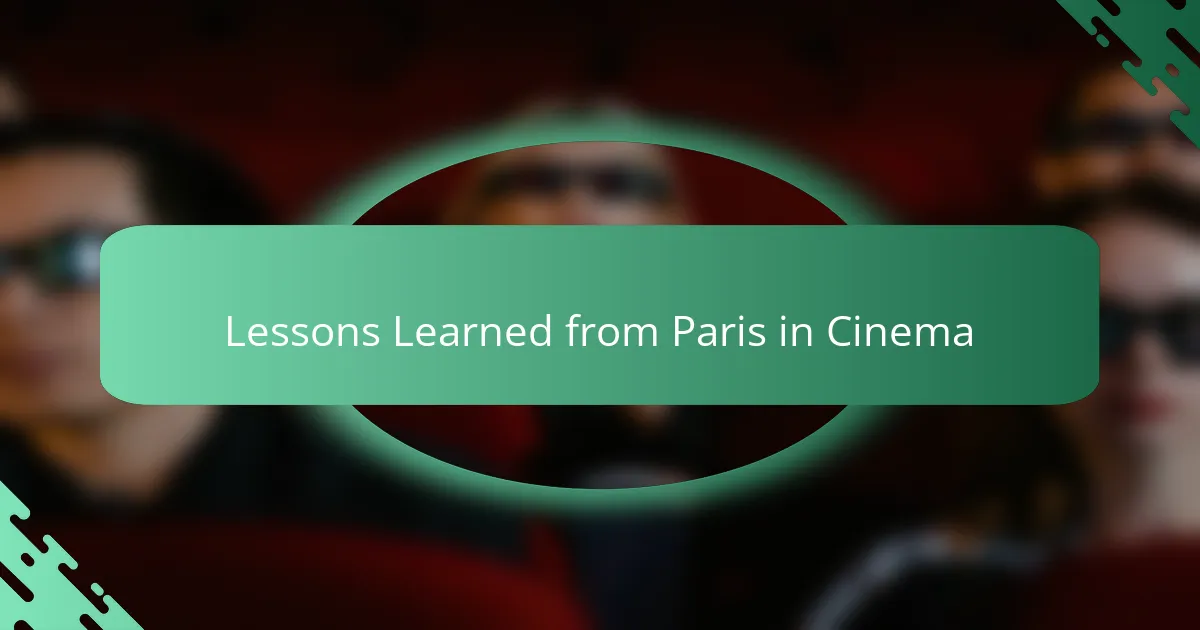
Lessons Learned from Paris in Cinema
The portrayal of Paris in cinema teaches us that a city is so much more than its physical beauty. I recall standing in front of the Eiffel Tower, feeling an overwhelming connection to films that immortalized its allure. How incredible is it that a place can carry such emotional weight, influencing our perception of love, creativity, and even personal growth? These narratives often remind us that our surroundings shape our experiences, showing the deep relationship we all have with locations that inspire us.
One lesson I’ve learned is the importance of authenticity in storytelling. While many films romanticize Paris, others effectively capture its challenges, offering a more complex view of life in the city. I remember watching “Les Misérables,” which powerfully illustrated social issues against the backdrop of Paris’s gritty streets. It hit home, making me reflect on both the beauty and the struggles inherent in everyday life. Isn’t it fascinating how cinema can spark a dialogue about societal realities while still celebrating the enchanting moments?
Lastly, the films set in Paris have a way of bringing out my wanderlust. Each time I finish a cinematic journey through the city, I find myself daydreaming about wandering its streets, sipping coffee at a tiny café, or visiting hidden gems. Isn’t it amazing how these films can compel us to explore beyond the surface? They serve as a reminder that in life, as in film, there’s always a deeper story waiting to be discovered.
